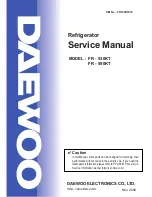
EN - 23 -
Climate class and meaning:
T (tropical):
This refrigerating appliance is intended to be used at ambient temperatures
ranging from 16 °C to 43 °C.
ST (subtropical):
This refrigerating appliance is intended to be used at ambient
temperatures ranging from 16 °C to 38 °C.
N (temperate):
This refrigerating appliance is intended to be used at ambient temperatures
ranging from 16 °C to 32 °C.
SN (extended temperate):
This refrigerating appliance is intended to be used at ambient
temperatures ranging from 10 °C to 32 °C.
•
To reduce humidity and avoid the consequent formation of frost, always store liquids in
sealed containers in the refrigerator. Frost tends to concentrate in the coldest parts of
the evaporating liquid and, in time, your appliance will require more frequent defrosting.
•
Never place warm food in the refrigerator. Warm food should be allowed to cool at room
temperature and should be arranged to ensure adequate air circulation in the refrigera-
tor compartment.
•
Make sure no items are in direct contact with the rear wall of the appliance as frost will
develop and packaging will stick to it. Do not open the refrigerator door frequently.
• We recommend that meat and clean fish are loosely wrapped and stored on the glass
shelf just above the vegetable bin where the air is cooler, as this provides the best stor-
age conditions.
•
Store loose fruit and vegetable items in the crisper containers.
•
Store loose fruit and vegetables in the crisper.
•
Storing fruit and vegetables separately helps prevent ethylene-sensitive vegetables
(green leaves, broccoli, carrot, etc.) being affected by ethylene-releaser fruits (banana,
peach, apricot, fig etc.).
•
Do not put wet vegetables into the refrigerator.
•
Storage time for all food products depends on the initial quality of the food and an un-
interrupted refrigeration cycle before refrigerator storage.
•
To avoid cross-contamination do not store meat products with fruit and vegetables.
Water leaking from meat may contaminate other products in the refrigerator. You should
package meat products and clean any leakages on the shelves.
• Do not put food in front of the air flow passage.
• Consume packaged foods before the recommended expiry date.
NOTE
: Potatoes, onions and garlic should not be stored in the refrigerator.
• For normal working conditions, it will be sufficient to adjust the temperature setting
of your refrigerator to +4 °C.
•
The temperature of the fridge compartment should be in the range of 0-8 °C, fresh foods
below 0 °C are iced and rotted, bacterial load increases above 8 °C, and spoils.
•
Do not put hot food in the refrigerator immediately, wait for the temperature to pass
outside. Hot foods increase the degree of your refrigerator and cause food poisoning
and unnecessary spoiling of the food.
• Meat, fish, etc. should be store in the chiller compartment of the food, and the vegetable
compartment is preferred for vegetables. (if available)
ARRANGING FOOD IN THE APPLIANCE
PART - 3.
Содержание VIC 10122 S
Страница 75: ......
Страница 76: ...52316689 ...
















































